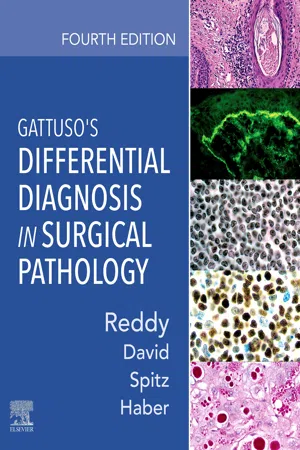
Gattuso's Differential Diagnosis in Surgical Pathology
- 1,148 pages
- English
- ePUB (mobile friendly)
- Available on iOS & Android
Gattuso's Differential Diagnosis in Surgical Pathology
About this book
Widely used by residents, fellows, and practicing pathologists around the world, Gattusso's Differential Diagnosis in Surgical Pathology provides a user-friendly road map to the main criteria to consider in order to differentiate between a variety of potential diagnoses that all have a very similar appearance. This comprehensive guide helps you make informed decisions for even your most complex and challenging cases, presenting a comprehensive differential diagnosis list and comparisons for every entity discussed. The 4th Edition brings you fully up to date with updated diagnostic techniques, new classifications, and new content throughout—perfect for quick reference at every microscope in the sign-out room.- Provides brief descriptions of both common and uncommon disorders, with an emphasis on differential diagnosis, along with excellent illustrative examples of the pathology and carefully selected references.- Streamlines the differential diagnosis process by offering a series of bullet point checklists that detail the respective features of the entities being considered.- Discusses a complete range of tumors and tumor-like conditions in all organ systems.- Contains updated information on personalized/precision medicine especially as it pertains to the immunotherapies; for example, PDL-1 targeted therapies in many cancers.- Includes new classification of neuroendocrine tumors, new classification and updates of follicular variant of papillary thyroid carcinoma, and a new section on the most common metastatic tumors and utilization of ancillary techniques for diagnosis and molecular studies.- Uses a reader friendly, outline format for each diagnosis that details clinical information, epidemiology, gross and microscopic findings, ancillary stains and tests, differential diagnoses, and pearls of wisdom.- Features 1, 400 full-color macro- and micrographs that provide a realistic basis for comparison of what you see under the microscope.- Enhanced eBook version included with purchase, which allows you to access all of the text, figures, and references from the book on a variety of devices
Frequently asked questions
- Essential is ideal for learners and professionals who enjoy exploring a wide range of subjects. Access the Essential Library with 800,000+ trusted titles and best-sellers across business, personal growth, and the humanities. Includes unlimited reading time and Standard Read Aloud voice.
- Complete: Perfect for advanced learners and researchers needing full, unrestricted access. Unlock 1.4M+ books across hundreds of subjects, including academic and specialized titles. The Complete Plan also includes advanced features like Premium Read Aloud and Research Assistant.
Please note we cannot support devices running on iOS 13 and Android 7 or earlier. Learn more about using the app.
Chapter 1: Special Diagnostic Techniques in Surgical Pathology
Abstract
Keywords
Tissue Processing Overview
- • Fixation
-
- • Preserves tissues in situ as close to the lifelike state as possible
- • Ideally, fixation will be carried out as soon as possible after removal of the tissues, and the fixative will kill the tissue quickly, thus preventing autolysis
- • Dehydration
-
- • Fixed tissue is too fragile to be sectioned and must be embedded first in a nonaqueous supporting medium (e.g., paraffin)
- • The tissue must first be dehydrated through a series of ethanol solutions
- • Clearing
-
- • Ethanol is not miscible with paraffin, so nonpolar solvents (e.g., xylene, toluene) are used as clearing agents; this also makes the tissue more translucent
- • Embedding
-
- • Paraffin is the usual embedding medium; however, tissues are sometimes embedded in a plastic resin, allowing for thinner sections (required for electron microscopy [EM])
- • This embedding process is important because the tissues must be aligned, or oriented, properly in the block of paraffin
- • Sectioning
-
- • Embedded in paraffin, which is similar in density to tissue, tissue can be sectioned at anywhere from 3 to 10 μm (routine sections are usually cut at 6 to 8 μm)
- • Staining
-
- • Allows for differentiation of the nuclear and cytoplasmic components of cells as well as the intercellular structure of the tissue
- • Cover-slipping
-
- • The stained section on the slide is covered with a thin piece of plastic or glass to protect the tissue from being scratched, to provide better optical quality for viewing under the microscope, and to preserve the tissue section for years
Table of contents
- Cover image
- Title page
- Table of Contents
- Copyright
- Dedication
- Contributors
- Preface
- Acknowledgments
- Chapter 1. Special Diagnostic Techniques in Surgical Pathology
- Chapter 2. Skin and Adnexal Structures
- Chapter 3. Head and Neck
- Chapter 4. Lung and Pleura
- Chapter 5. Thymus and Mediastinum
- Chapter 6. Gastrointestinal System
- Chapter 7. Hepatobiliary System
- Chapter 8. Pancreas
- Chapter 9. Adrenal Gland
- Chapter 10. Ureter, Urinary Bladder, and Kidney
- Chapter 11. Male Genitourinary System
- Chapter 12. Female Reproductive System
- Chapter 13. Breast
- Chapter 14. Lymph Nodes
- Chapter 15. Spleen
- Chapter 16. Bones and Joints
- Chapter 17. Soft Tissue
- Chapter 18. Heart, Pericardium, and Blood Vessels
- Chapter 19. Central Nervous System
- Chapter 20. Eye and Orbit
- Index